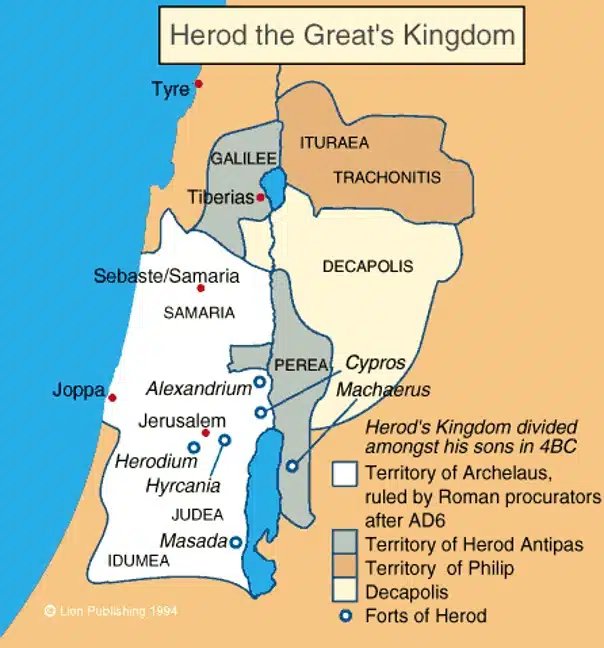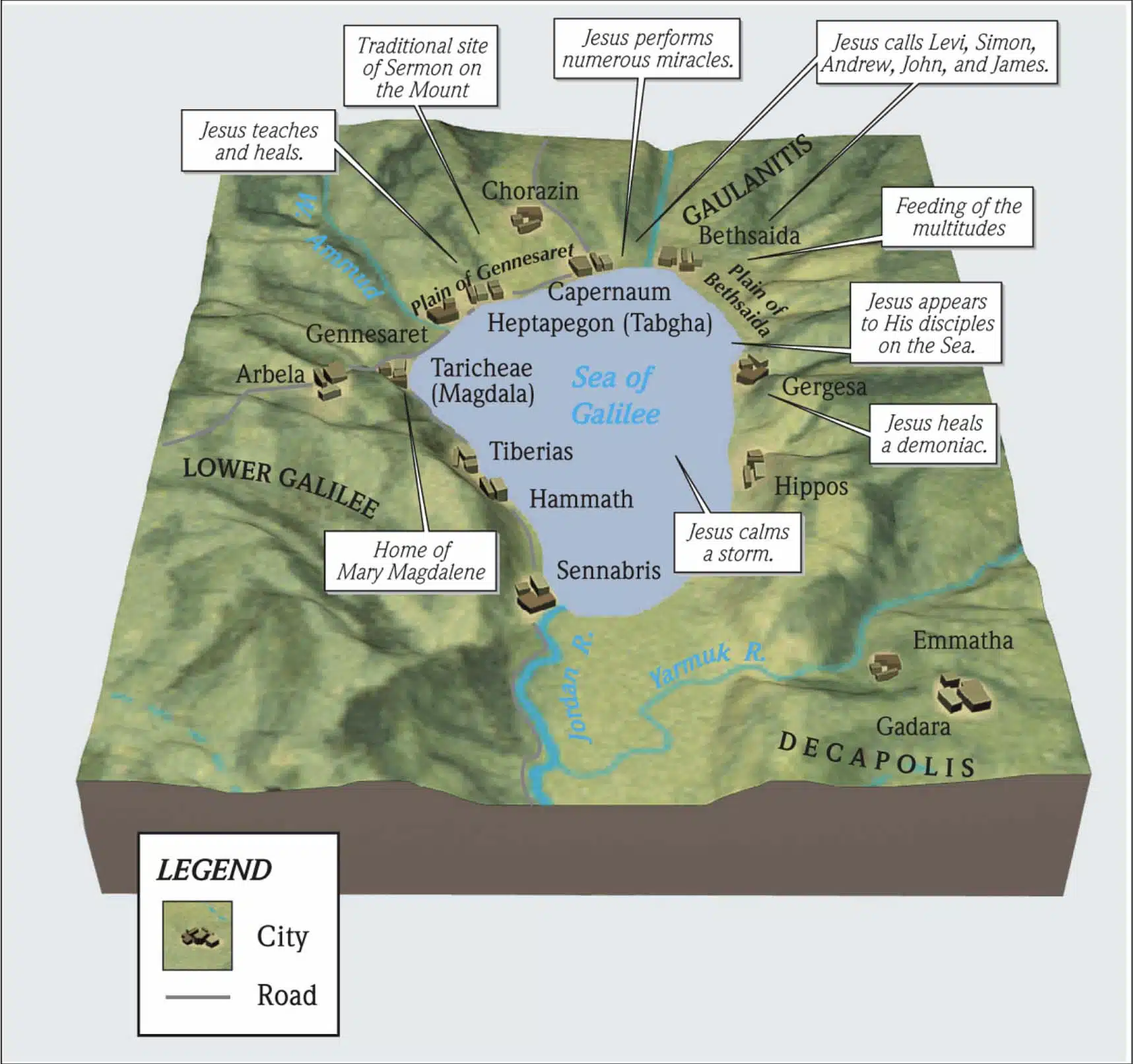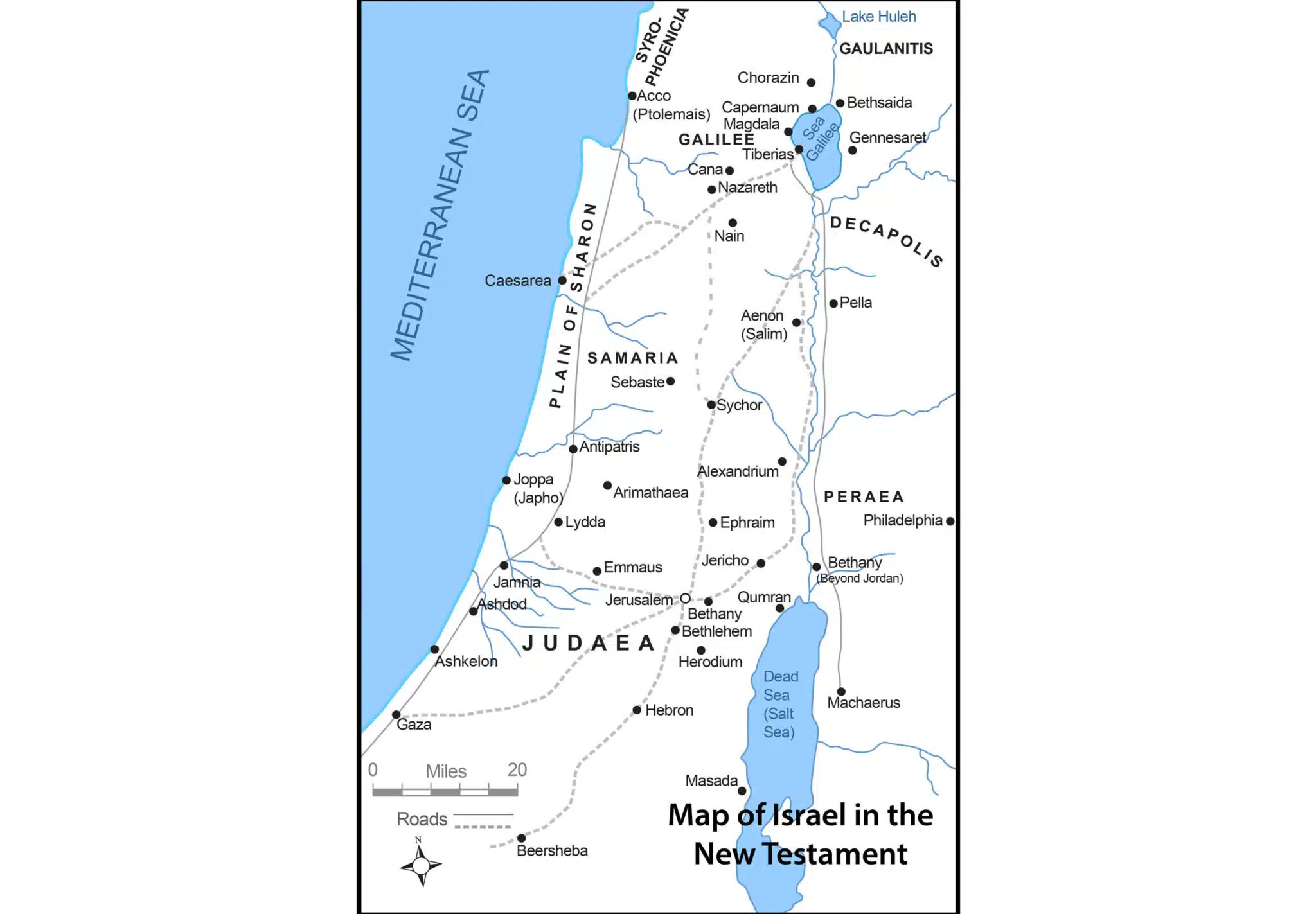Jesus and disciples arrive ashore and the word quickly spreads of His arrival. The people bring many who are sick to be healed by Jesus.
The parallel gospel accounts of Matthew 14:34-36 are found in Mark 6:53-56 and John 6:22-71.
After Jesus came to the disciples and calmed the storm Jesus and the disciples crossed over the sea. Geopolitically, they had left the province of Gaulanitis and crossed over the provincial border into Galilee. Matthew and Mark report that they came to land at Gennesaret (v 34) (Mark 6:33). John however reports that they landed at the city of Capernaum (John 6:24). Gennesaret is the Hellenized version of the Hebrew name “Chinnereth,” which is what the Israel called the Sea of Galilee from the time of Joshua and the conquest.
The phrase came to land at Gennesaret (v 34) has two possible meanings. It could mean the town of Gennesaret, located on western shore of Galilee. The town was halfway between the cities of Magdala (which was situated on the western shore at the lake’s north/south midpoint) and Capernaum (which was located on the northern shore at the lake’s east/west midpoint). But the phrase came to land at Gennesaret (v 34) could also mean the shoreline between the cities of Gennesaret and Capernaum. This shoreline was often called “the plain of Gennesaret.” It seems Matthew and Mark meant this second meaning, making their account compatible with John’s account. Matthew and Mark identify the region that Jesus and disciples came ashore. John identifies the city.
Unsurprisingly, the men of that place recognized Jesus (v 35). Capernaum and the surrounding region was where Jesus initiated His ministry. Here He taught about the kingdom, called many of His disciples, and performed numerous miracles. This was where Jesus’s ministry was unofficially headquartered. Moreover, it was many of these people who trekked the dozen-mile or more round trip to see Jesus and were among the five thousand men who miraculously fed by Him the previous evening.
When they recognized Him, they quickly sent word into all that surrounding district (v 35) of Jesus’s whereabouts. The news of Jesus’s miracle feeding the multitudes with only a few loaves and fish had already travelled around the entire lake. Boats from the town of Tiberias on the southwest shore had already set out for Gaulanitis where Jesus had performed the miracle and was last seen in public (John 6:23). Jesus, of course, having walked across the sea, was no longer there. And they were still searching for Him when they were given the word that He was in Capernaum.
Matthew and Mark report that the people brought to Jesus all who were sick (v 35). Some of them even carried those who could not walk on pallets to Him to be healed (Mark 6:55). The sick and injured implored Jesus to see if He would allow them to just touch the fringe of His cloak (v 36) in the belief that they might be cured. The fringe of His cloak (v 36) refers to the tassels of His rabbinic shawl. The people supposed that a rabbi’s tassels displayed the righteousness of that rabbi and somehow stored and released any power the rabbi had. (This was what the woman with the twelve year hemorrhage also believed in Matthew 9:20-22). The religious leaders also preyed upon the people’s supposition and lengthened their tassels to advertise their “righteousness” (Matthew 23:5). Matthew and Mark factually report that as many as touched it were cured (v 36).
Jesus did more than just heal the sick on this day. John reports that Jesus also taught in the synagogue at Capernaum (John 6:26-71) correlating His recent miracle of feeding the five thousand with God’s miraculous provision of manna during the time of Moses. In a discussion with the Jews, Jesus identified Himself as the bread from heaven. There Jesus told them that His body was the true food, and His blood the true drink that must be consumed in order to live forever. These statements were misunderstood and turned many Jews, including many of his disciples, away from Him.
Biblical Text
34 When they had crossed over, they came to land at Gennesaret. 35 And when the men of that place recognized Him, they sent word into all that surrounding district and brought to Him all who were sick; 36 and they implored Him that they might just touch the fringe of His cloak; and as many as touched it were cured.
Check out our other commentaries:
-
Deuteronomy 12:15-16 meaning
Moses gives guidelines concerning the slaughter of animals to be used for meals and not for sacrifices....... -
Exodus 3:11-12 meaning
Moses is not convinced that he is the right person for the job of delivering the Israelites. In fact, he responds to the LORD with...... -
Exodus 8:1-15 meaning
The second plague involves an overwhelming infestation of frogs. There was to be no place in Egypt where the frogs were not present in large...... -
Matthew 9:35-38 meaning
Jesus feels compassion for the people of Galilee. He tells His disciples that the harvest for the gospel is bountiful, but there are few workers....... -
Leviticus 1:14-17 meaning
The LORD gives Moses instructions for bird offerings.......





